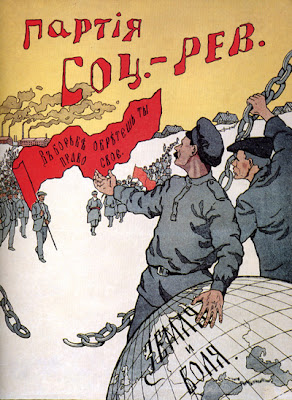Socialist-Revolutionary Party election poster, 1917
Until recently I was entirely unaware of the word and concept "maximalism". Lately, however, I have heard it used more and more, especially in remarks made in the course of and news reporting concerning contemporary U.S. politics. I became curious about its origin and through dictionary and encyclopedia research I found that the term actually originated in early 20th century Russia, its first known use occurring in connection with the Party of Socialist Revolutionaries in 1906. (Please see discussion in I(a) below.) Maximalism has since been adopted by successor fringe political movements (please see I(b) below), in mathematics (especially in connection with order theory), in the arts and aesthetics (e.g., music, literature, visual arts), and even in theology.
Although over 100 years old, the term "maximalism"
(usually appearing in the form "maximallist" or "maximal") continues (to
my ears at least) to have the grating sound of neologism. Whenever I hear the word used, the speaker seems to change his or her facial expression, a large "thought balloon" appearing behind them, bearing the legend:
I. Maximalism
(a) The Party of Socialists-Revolutionaries (PSR, the SRs, or Esers; Russian: Партия социалистов-революционеров (ПСР), эсеры) was a major political party in early 20th century Russia and a key player in the Russian Revolution. After the February Revolution of 1917 it shared power with other liberal and democratic socialist forces within the Russian Provisional Government. In November 1917, it won the majority of the national vote in Russia's first-ever democratic elections (to the Russian Constituent Assembly), but soon split and was defeated and destroyed by the Bolsheviks in the course of the Russian Civil War and subsequent persecution.
The "Union of Socialists-Revolutionaries Maximalists", a radical faction within the PSR, united agrarian terrorists, the 'Moscow Opposition' and
other radical dissidents from the PSR in an independent party. The
Maximalists officially split off from the PSR at its Second Congress in
Imatra in 1906. Maximalists played a role in both the Revolution of 1905 and the Revolution of 1917. Many former SR Maximalists eventually joined the Russian Communist Party (Bolshevik).
The SR Maximalists held a favorable view of terror and expropriation were often compared to anarchists, with whom they shared a fondness for
'propaganda by the deed' and 'direct action'. They were not opposed to the concept of the
state as such and envisaged a popular revolutionary dictatorship. They
rejected parliamentary democracy as a mere 'lighnin rod of popular
discontent'.
(b) Abba Ahimeir (Hebrew: אב"א אחימאיר, 2 November 1897 - 6 June 1962) was a Jewish journalist, historian and political activist. One of the ideologues of Revisionist Zionism, he was the founder of the self-described "fascist" Revisionist Maximalist faction of the Zionist Revisionist Movement (ZRM) and of the clandestine Brit HaBirionim, which had a profound influence on the ideology of the Irgun and Lehi undergrounds. There is inadequate space in this brief post to discuss Ahimeir's views and writings, which remain controversial, in detail. Ahimeir's strong resemblance to silent-movie era superstar comedian Harold Lloyd is hereby noted.
II. Minimalism
Donald Judd, Untitled, 1969/82
Walter de Maria, Vertical Earth Kilometer, 1977
Robert Morris, Box With The Sound Of Its Own Making, 1961
Carl Andre, Sum Roma, 1997
Robert Smithson, Spiral Jetty, 1970
Walter de Maria, Lightning Field, 1977
[1] Look At Me, I'm Wonderful, The Bonzo Dog Band, 1969 (from Kenysham) (Click link above or HERE)










No comments:
Post a Comment